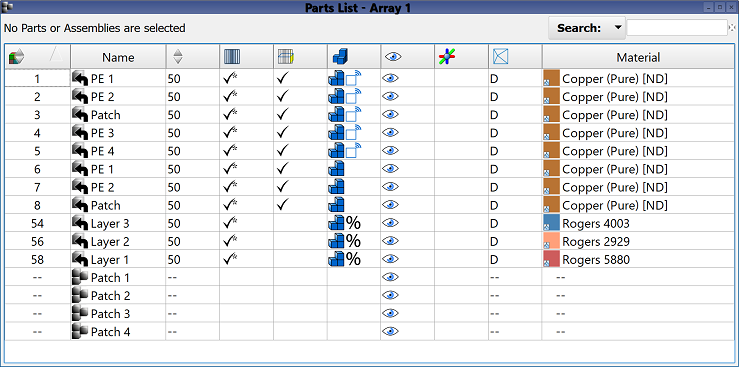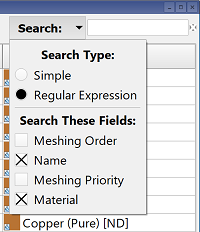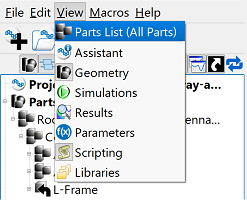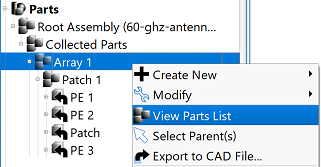
The assembly path of a selected part appears in the upper-left corner of the window and is useful for copy-and-paste operations. The number of selected parts appears when two or more items are selected, and mousing over this information displays the assembly path of each individual part.

In the upper-right corner of the window, users can manually enter text into the Search field and use the drop-down arrow to access additional filtering criteria.
The Search Type determines what search terminology is considered valid:
- Simple: default search for case insensitive text matches, which are displayed as terms are entered.
- Regular Expression: case insensitive search for multiple terms separated by a vertical bar without spaces, and followed by pressing Enter. For example, patch|metal 2.
When choosing the Regular Expression search, users should note that entering a space either before or after a vertical bar returns incomplete search results. The Search These Fields options specify which fields are searched for the terms entered in the Search bar. The available selections include fields with either numeral or text entries, such as the Meshing Order, Name, Meshing Priority, and Material.
Users can adjust individual settings by right-clicking on a part and choosing the menu option associated with the desired field. Clicking the column's header and using the ![]() or
or ![]() buttons toggle between decending and ascending order, respectively.
buttons toggle between decending and ascending order, respectively.
The parts list fields display the following information:
 : the meshing order in which each part is meshed, as determined by the three rules.
: the meshing order in which each part is meshed, as determined by the three rules.- Name: part identifier defined when creating geometry.
 : meshing priority assigned to co-incident, overlapping, and intersecting parts. Increasing or decreasing this value either raises or lowers a part's meshing order, respectively.
: meshing priority assigned to co-incident, overlapping, and intersecting parts. Increasing or decreasing this value either raises or lowers a part's meshing order, respectively.  : symbol indicates enabled grid region.
: symbol indicates enabled grid region.  manual grid region is enabled.
manual grid region is enabled. PrOGrid grid region is enabled.
PrOGrid grid region is enabled. : symbol indicates enabled automatic fixed points.
: symbol indicates enabled automatic fixed points. : symbol indicates enabled meshing.
: symbol indicates enabled meshing. staircased mesh is applied.
staircased mesh is applied. XACT is enabled.
XACT is enabled. dielectric volume averaging is enabled.
dielectric volume averaging is enabled. singularity correction is enabled.
singularity correction is enabled. : symbol indicates enabled visibility.
: symbol indicates enabled visibility. : symbol indicates a part with locators.
: symbol indicates a part with locators.  : letter indicates which of the four faceting quality settings is applied to a part.
: letter indicates which of the four faceting quality settings is applied to a part.- D: default.
- M: medium.
- H: high.
- C: custom.
- Material: a part's material assignment.

